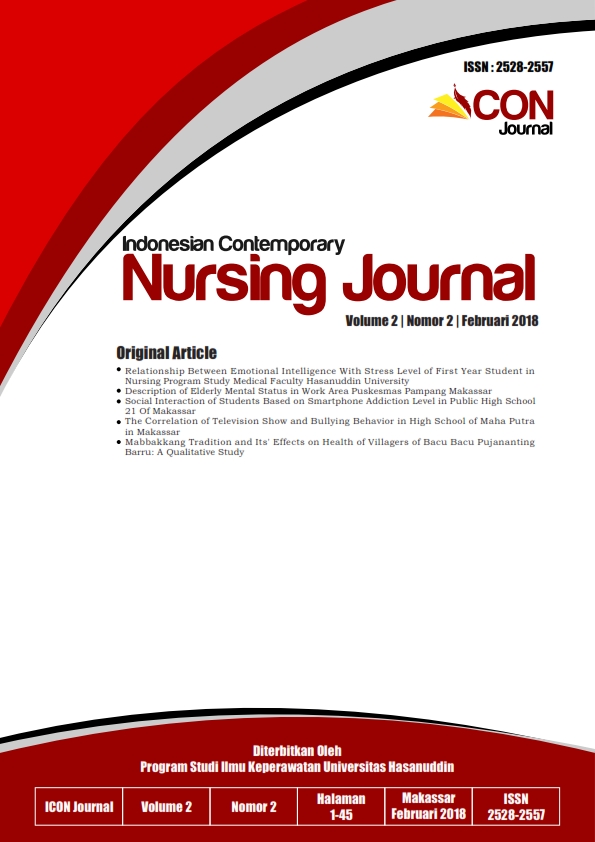Social Interaction of Students Based on Smartphone Addiction Level in Public High School 21 of Makassar
Abstract
Introduction: Smartphone is currently a tool for communications that is widely used by all people, especially among high school students. Excessive use of smartphone can lead to smartphone addiction. Someone who has a smartphone addiction have anti-social behavior towards his environment. This study aimed to describe of social interaction on the male and female students who have a smartphone addiction in SMA Negeri 21 Makassar. Method: This study design used is quantitative with descriptive survey. Selection of sample using cluster random sampling, total 95 respondent. Primary data obtained through questionnaires. Result: Based on the results of a study of 95 respondents, shows that respondents who experienced low-level smartphone addiction 19 people (28.8%) had a high social interaction, similar with respondents who experienced medium-level of smartphone addiction 43 people (65.2%) and high-level 4 people (6.1%) had a high social interaction. Conclusions: The study concluded that all levels of smartphone addiction has a high social interaction, not all respondents who use smartphones tend to be indifferent to his surroundings. They remain more comfortable communicating directly with the people closest. This research is expected can provide benefits that can be used as information specifically for students of SMAN 21 Makassar, and can improve socialization skills in the environment so that it can improve social interaction began to crushedDownloads
Download data is not yet available.
Dimensions
Published
2019-09-30
How to Cite
Seftiani, R. Y., Nurdin, N., Harisa, A., Hapsah, H., & Jafar, N. (2019). Social Interaction of Students Based on Smartphone Addiction Level in Public High School 21 of Makassar. Indonesian Contemporary Nursing Journal (ICON Journal), 2(2). https://doi.org/10.20956/icon.v2i2.7808
Issue
Section
ARTICLES
Copyright & Licensing
Authors who publish with this journal agree to the following terms:
Authors retain copyright and grant the journal right of first publication with the work simultaneously licensed under a Creative Commons Attribution License that allows others to share the work with an acknowledgement of the work's authorship and initial publication in this journal.
Authors are able to enter into separate, additional contractual arrangements for the non-exclusive distribution of the journal's published version of the work (e.g., post it to an institutional repository or publish it in a book), with an acknowledgement of its initial publication in this journal.
Authors are permitted and encouraged to post their work online (e.g., in institutional repositories or on their website) prior to and during the submission process, as it can lead to productive exchanges, as well as earlier and greater citation of published work (See The Effect of Open Access).
Authors retain copyright and grant the journal right of first publication with the work simultaneously licensed under a Creative Commons Attribution License that allows others to share the work with an acknowledgement of the work's authorship and initial publication in this journal.
Authors are able to enter into separate, additional contractual arrangements for the non-exclusive distribution of the journal's published version of the work (e.g., post it to an institutional repository or publish it in a book), with an acknowledgement of its initial publication in this journal.
Authors are permitted and encouraged to post their work online (e.g., in institutional repositories or on their website) prior to and during the submission process, as it can lead to productive exchanges, as well as earlier and greater citation of published work (See The Effect of Open Access).
Most read articles by the same author(s)
- Darmiaty Darmiaty, Nuurhidayat Jafar, Silvia Malasari, Screening and Assessment of Nutritional Status on Elderly in Pampang, Makassar , Indonesian Contemporary Nursing Journal (ICON Journal): Volume 1 No. 2 Februari 2017
- Ismayani Safitri, Hapsah Hapsah, Akbar Harisa, Nurses Attitude Toward Patients as A Translating of Nursing Code of Ethics in Universitas Hasanuddin Hospital , Indonesian Contemporary Nursing Journal (ICON Journal): Volume 4 No. 2 Februari 2020
- Hasnah Hasnah, Desy Ana Hendra, Hapsah Hapsah, Correlation Between Emotional Intelligence and Problem Solving Skill of Health Students of Faculty of Medicine Universitas Hasanuddin , Indonesian Contemporary Nursing Journal (ICON Journal): Volume 3 No. 1 Agustus 2018
- Hasnah Hasnah, Hapsah Hapsah, Silvia Malasari, Ariyanti Saleh, Akbar Harisa, Nurses’ Experience of Dealing With Patients’ Aggressive Behaviour in Psychiatric Emergency Ward of Hospital in South Sulawesi , Indonesian Contemporary Nursing Journal (ICON Journal): Volume 3 No. 1 Agustus 2018
- Muhnia Muhnia, Wa Ode Nur Isnah, Hapsah Hapsah, Relationship Between Emotional Intelligence With Stress Level of First Year Student in Nursing Program Study Medical Faculty Hasanuddin University , Indonesian Contemporary Nursing Journal (ICON Journal): Volume 2 No. 2 Februari 2018
- Hasriana Sari, Nuurhidayat Jafar, Silvia Malasari, Healthy Environment Development in School Health Units of Public Primary Schools in Bontobahari Bulukumba , Indonesian Contemporary Nursing Journal (ICON Journal): Volume 1 No. 2 Februari 2017
- Nuurhidayat Jafar, Nur Fadilah, Silvia Malasari, Moh Syafar Sangkala, Andina Setyawati, Andi Wahyuni, Mosquito Nests Eradication through Monitoring the Mosquito Larva (Jumantik) by School Children in Preventing the Dengue Hemorrhagic Fever , Indonesian Contemporary Nursing Journal (ICON Journal): Volume 3 No. 2 Februari 2019
- Debi Sambak, Tuti Seniwati, Akbar Harisa, The Storytelling and Improvement of Language and Social Skills in Autism Children , Indonesian Contemporary Nursing Journal (ICON Journal): Volume 6 No. 1 Agustus 2021
- Salsa Bella Fitri Pagesa, Akbar Harisa, Nurhaya Nurdin, Moh. Syafar Sangkala, Silvia Malasari, Health Literacy Level of Nursing Students in The Islamic Colleges of Makassar City , Indonesian Contemporary Nursing Journal (ICON Journal): Volume 6 No. 2 Februari 2022
- Desy Ana Hendra, Hapsah Hapsah, Silvia Malasari, Yuliana Syam, Andriani Andriani, Emotional Question of Students in Undergraduate Course of School of Nursing Hasanuddin University , Indonesian Contemporary Nursing Journal (ICON Journal): Volume 2 No. 1 Agustus 2017

